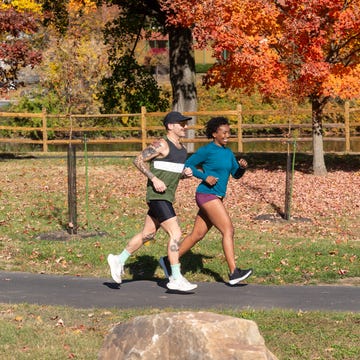Whether your goal is your first 5K or an ultramarathon, you want to follow a training plan. And every good training plan has one thing in common: phases. Each training phase—base, build, peak, taper, and recovery—helps you gradually adapt to greater physical demands and the challenges of a specific race goal.
Smart training techniques will help you tackle both physical and mental challenges, Kristen Hislop, a USAT Level 1 certified triathlon coach and Positive Performance Mindset coach tells Runner’s World, and this will translate to the rest of your life, too. “If you can learn to deal with adversity on the roads or trails, you can certainly tackle life’s other roadblocks with a bit more ease,” she adds.
Here, experts offer a few ways to conquer each of those phases. Keep these in mind as you check off each run and, if you keep a training log, make a note of the strategies you used to remember which ones work best.
Fight the Boredom of Base Training
Boredom is often the biggest mental hurdle of base training, because this phase lasts up to eight or 12 weeks (although it will be shorter if you’re a more experienced runner).
Throughout these weeks, focus on building consistency. Physically, these runs strengthen connective tissues for later, more challenging phases and build a base of cardio and muscular strength.
Without interval and speedwork, you have to manage easy miles to keep your long term commitment. The solution? Remove any steps that keep you from getting to your training session, according to Hislop. “I think there are some basic physical and mental things people can do to create the right habits,” she says.
1. Lay out your clothes the night before
“Check the weather, put out the clothing and you’ll be more likely to get up and go,” says Hislop. Be prepared, too, and pack and dress accordingly for the weather so you don’t have a last minute excuse not to run.
2. Create mini goals with small rewards
For instance, aim for three runs each week, and promise yourself a reward, like a new shirt or massage, if you keep to your schedule for a couple of weeks.
3. Seek social support and accountability
Running groups and challenges, whether in person or virtual, are great options, VDOT and UESCA-certified run coach Amy Clark, PT, ScD, OCS, tells Runner’s World. Research suggests social networks, including apps like Strava, increase training frequency. “You will be able to run with like-minded people who can not only make it fun, but give you accountability as well,” says Clark.
Don’t Fear the Build Phase
The four to eight-week build phase requires perseverance as you adapt to more intensity and the discomfort and fatigue that go along with it. Increasing your speed and pushing your threshold with tempo and interval training can cause mental pressure. “The build phase is the place to embrace the suck,” says Hislop. “This is where we learn that it is okay to be uncomfortable—it is in this phase that we grow and adapt.”
1. Know your why
Hislop suggests asking yourself why you set out on this journey and to define both your outcome and process goals. Outcome goals are usually more straightforward, like qualifying for Boston or running a 12-minute mile. “The process goals are super important,” says Hislop. “Those are: ‘I want to feel good at mile 20, I want to finish the run feeling stronger than when I started.’”
2. Reframe discomfort
Self-talk can help reframe discomfort into a positive challenge. Clark suggests telling yourself, “Cool, I get to see how fast I can go for 6 minutes today,” instead of “Can I possibly hold that pace for 6 minutes?”
3. Track your progress
Journaling your progress helps you see how far you’ve come and puts perceived “failures” in perspective, says Hislop. Reflect on any perceived failures, identify lessons learned, and move on, adds Clark.
Don’t Let the Peak Overwhelm You
Peak training requires pushing through significant physical and mental fatigue. Pressure mounts while getting in key workouts over eight to 10 weeks (or more), with the highest mileage and intensity required to reach peak fitness.
Carefully avoiding burnout and handling inevitable ups and downs is key during the peak phase. “Most of us are also working full time jobs, have families—it’s easy to look at the entire week and be a little overwhelmed by the mileage,” says Clark.
1. Align your mindset
Having the right mindset is crucial for avoiding overwhelm. “I like to reel my runners in here and try to have them focus on one workout at a time,” says Clark. She also emphasizes truly taking easy days easy.
2. Use visualization
Visualization is a powerful way to stay focused and motivated. Hislop recommends visualizing yourself pushing through a barrier rather than just thinking about hitting a time. She also suggests writing a race script detailing how you will feel and what you’ll say to yourself during tough moments.
3. Psychological skills training
Learning skills like cognitive control, relaxation, and self-talk will help manage stress and prevent choking under pressure. These skills also boost focus and enable you to handle pain during strenuous efforts.
Don’t Tantrum Through Taper
While it lasts only two to three weeks, the taper phase can be frustrating, especially one whose training helps them decrease stress levels. The taper reduces run volume and intensity, prioritizes recovery, and stores energy.
Often this comes with “taper tantrums,” spurred partly by prerace nerves, and many people find rest difficult, says Hislop. “As you come into a taper, the training is done—the key now is to fine tune the mind and allow the body to rest.”
1. Reframe anxiety with mantras
“What we see as prerace anxiety is the same feeling as prerace excitement—it is all about perspective,” she says. Turning anxiety into excitement takes practice, says Clark. “It is helpful to start thinking about your mantra(s)—what words will you lean into when things get tough?”
2. Make a plan
Now that you have more time, Hislop and Clark advise that you work through “what ifs,” (weather, traffic) and focus on the elements you can control. For example, make sure you understand all the race logistics, such as parking, what time you will get there, and where the Porta-Potties are.
3. Practice relaxation
Clark advises runners use moments of silence and relaxation while imagining specific race scenarios. “Visualize how you will navigate through that section, really feel it, practice what you will tell yourself to get up that hill,” she says, although stop yourself from obsessing about the details. “Tell yourself you can have 10-15 minutes of mental imagery per day, but the rest of the time focus on other things,” says Clark.
Remember, Recovery Is a Phase
While the hard work is over, the recovery phase, usually a couple of weeks if you’ve run a half marathon or marathon, supports tissue repair and gives you time to restore balance to your life (take a few weeks off from long runs!). It’s a time for assessment, redefining your goals, and yes, resisting the urge to train too soon.
Some people also experience postrace depression. “My newer runners are surprised that ‘postrace depression’ truly exists,” says Clark. “I try to educate them on why taking a short break after a race is important. I want their bodies to have time to heal, and I want them hungry and motivated when they come back!”
1. Reflect and assess.
Hislop urges runners to use this time to celebrate their process and outcome goals. “Write down what went well, what would you do differently,” she says. Add these thoughts to your journal to track your progress each training cycle. Frontiers in Sports and Active Living research with distance runners showed that mindfulness helps aid mental rest and regeneration during this phase.
2. Stay connected.
Taking at least two weeks off from running after your first marathon is essential for your body, says Clark, but you should still stay connected with your running group, through social media or IRL get togethers.
Reset for the Next Cycle
Mental strategies can help you navigate the five training phases, and just like you take notes on your metrics, the coaches encourage you to also be aware of your thinking around each run. This way, you’ll better identify which methods works best.
To do this, Hislop advises reflecting on the past cycle, celebrating your recent accomplishments, and setting a new goal on your calendar. “You already have a base, you are already ahead of where you started last time,” says Hislop.
To start your next cycle, embrace a beginner’s mindset so you can focus on the work ahead and the learning opportunities that come with it.














